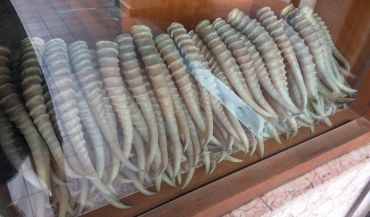
Credit: Shutterstock
Beyond regulating trade: understanding the consumers driving Saiga horn demand
By Hunter Doughty
The saiga is a Star-Wars looking Critically Endangered antelope from Central Asia, whose horn is used in traditional Chinese medicines (TCM). Last month, a new ruling by the Convention on International Trade in Endangered Species of Wild Fauna and Flora strengthened trade regulations around saiga product exports. However, conservationists have argued (for numerous unsustainably used wildlife products, such as elephant ivory and rhino horn) that demand reduction and not just trade regulation, is vital to long-term, effective solutions. And unfortunately, this consumer-focused attention is still limited for many lesser known species, like the saiga, that are being impacted by poaching.
 Saiga horn sold as medicinal remedy
Saiga horn sold as medicinal remedySaiga horn is mainly used to treat fever and heatiness (a TCM state of illness with symptoms like nasal congestion and sore throat). Poaching of saigas in the 1990s took out more than 95% of the population, and poaching still persists today, despite many policy and on-the-ground efforts from range states and international bodies. In addition to this hunting pressure, saigas have also been heavily impacted in recent years by mass bacterial and viral disease outbreaks.
To address the dire attention gap around saiga horn consumers, our work, published today in PLOS One, represents the most extensive research to date on a saiga consumer population. We conducted over 2200 consumer surveys in Singapore with members of the general Chinese Singaporean population. Singapore is recognised as a top saiga consumer country, and within the country, legal-with-permit saiga horn products are marketed most commonly as ling yang (羚羊), antelope’s horn, or "Cornu Saiga tataricae".
Through our work we found that 19% of respondents were high-level saiga horn users. This means that they consider saiga horn to be a product they use most often to treat heatiness or fever in themselves and others. Additionally, 47% of individuals who buy saiga horn for themselves were also buying it for someone else. We saw that saiga horn users were most likely to be middle-aged Buddhist or Taoists, however, horn use was seen across almost all demographic groups.
Consumer research like this one is a first and necessary step in demand reduction efforts. By thoroughly understanding a user group you can more accurately design behavioural interventions targeting unsustainable consumption, or really any undesirable behaviour. Such evidence-based interventions are being conducted every day in fields like public health and development, targeting behaviours that range from alcohohism, to poverty alleviation, and excessive meat consumption.
One key insight we found, for instance, is that TCM shopkeepers and an individual’s family are the most likely people to have recommended saiga horn to someone, thus these are the influencers that can be utilised in a behavioural intervention. Shopkeepers, for example, fill a similar role as a western pharmacist, and pharmacist-dessiminated health interventions are a common tool that a shopkeeper-disseminated intervention could be based on.
We also found that saiga horn users had a greater overall propensity for perceiving animals that are used in TCM as being common in the wild (regardless of the animals’ actual conservation status), and that this difference was especially significant for saiga. Identifying an awareness gap like this one gives a clear possible angle for a future project message that strives to drive up conservation concern in a socially relevant way.
 Saiga horns for sale
Saiga horns for saleSaiga horn use in Singapore is extensive, and non-negligible. And if attention remains solely on the supply-side of an unsustainable or illegal wildlife trade, then the root of the problem - consumer demand - will continue to drive poaching until there are no individuals left to poach.
Hunter Doughty is part of the Department of Zoology and this research features in the Oxford Martin Programme on the Illegal Wildlife Trade.
Read the full paper, 'Saiga horn user characteristics, motivations, and purchasing behaviour in Singapore'.